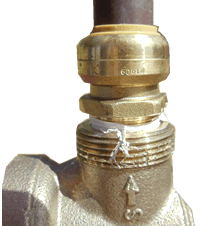Installing a Pressure Regulator using Sharkebite™ Fittings
Prevent damage to your plumbing and waste due to excess pressure in you irrigation system by installing a water pressure regulator at the water meter. Greg shows you how, step by step.

In this installation, he demonstrates the use of no-solder Sharkbite™ brand fittings. These fittings are great for the DIYer, as they require no special skills, are quick and easy to install for a water-tight seal, and can even be removed easily and used again!
Water company street pressure is often much higher than the recommended 80 psi for landscape and household plumbing. This puts the pipes under higher stress than necessary and more likely to leak and break over time. Sprinkler systems with too high a pressure will mist excessively, often wasting 50% of the water applied.
This video shows a southern California water meter installation. Meter location and configuration will vary by region, as dictated by local codes and weather (in Northern climates the meters are often in the house where they cannot freeze); however, the principle remains the same: protect ALL the pipe that is on the homeowner's side of the meter, not just what goes directly into the building.
| Time to complete | One to two hours ( Your water will be shut off during the entire job. Be sure to allow extra time for troubleshooting - don't start shortly before dark.) |
| Materials | pipe cutting tool of your choice, Pressure regulator, Sharkbite™ fittings, wrenches, teflon tape, screw-on pressure guage |
| Costs | about $150 (regulators up to about $120, plus the Sharkbites at about $8 or $9 for ¾") |
| Skill level | Medium |
| Troubleshooting | Leaks after installation may require tightening or new washers - especially if disturbing an older installation. Be careful not to start your project when stores are about to close or professional help is not avaiable (or at a premium price-like on holidays or weekends) |
| Safety Issues | Be careful of contamination entering the supply pipe. Adequate flushing afterwards is recommended |
| Property damage potential | Beware of buried power, phone, and other utility lines whenever digging. Call for line location if digging is required. |